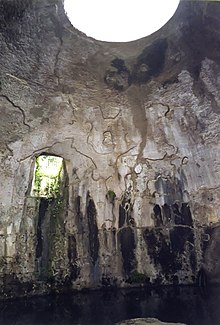Baiae
Baiae was an ancient settlement on the Gulf of Naples . Today the successor town of Baia is a district of the city of Bacoli .
location
Baiae is located on the northwestern edge of the Gulf of Naples between Puteoli and the Misenum peninsula .
history

Baiae was the old port of Cumae , a city founded by Greek colonists . The name is said to come from Baios , the helmsman of Odysseus . It always remained dependent on Cumae.
Baiae was known for its springs and developed into a popular medicinal bath and resort , especially in the late Roman Republic and at the beginning of the imperial era . Numerous wealthy Romans such as Caesar or Cicero had elaborate villas built in the vicinity of the city. Roman emperors such as Caligula , Nero or Hadrian also stayed there temporarily; part of the Baiae area had been imperial property since Augustus .
The life of pleasure in Baiae was proverbial; this is how Cicero described it in his defense speech for Caelius . Ovid described Baiae as a suitable place for love games. Some contemporaries such as Seneca , who called the place a “rest house of vices” ( deversorium vitiorum ), criticized the easy life in Baiae.
archeology
In Baiae, extensive remains of ancient thermal baths have been preserved, which are now located in an archaeological park . Three Roman domed buildings have traditional names as “temples”, but actually belonged to thermal baths.
| Data | Temple of Diana | Temple of Venus | Temple of Mercury |
|---|---|---|---|
| Built | 2nd century AD | 2nd century AD | 1st century BC Chr. |
| Inner dome diameter (⌀) | 29.50 m | 26.30 m | 21.55 m |
| Dome shell thickness | 1.20 m | ||
| Dome shell thickness to ⌀ | 1:25 | ||
| Wall thickness | 5.70 m | 2.90 m | |
| Wall thickness to ⌀ | 1: 5.2 | 1: 9.1 | |
| Dome material | concrete | ||
| Diameter opaion | 3.65 m | ||
| Diameter opaion to ⌀ | 1: 5.9 |
This bathing complex is considered the first large dome in the world and was already made of Roman concrete .
- Underwater archaeological park
Due to changes in the sea level ( bradyseism ), parts of the ancient site are now under water, where an archaeological reserve - the Baiae Underwater Archaeological Park (Parco Archeologico Sommerso di Baia) - has been set up, which can be visited from boats or during dives, which the Association Assodiving flegrean be organized. (Supervision of the park is currently the responsibility of the Archaeological Authority of Naples and Caserta.)
literature
- Mariarosaria Borriello, Antonio D'Ambrosio: Baiae-Misenium. Olschki, Florence 1979 ( Forma Italiae . Volume 27: Regio I, Vol. XIV ).
- Howard Comfort : Baiae, Campania, Italy . In: Richard Stillwell et al. a. (Ed.): The Princeton Encyclopedia of Classical Sites. Princeton University Press, Princeton NJ 1976, ISBN 0-691-03542-3 .
- Fritz Goldkuhle: The ruins of the Temple of Venus in Baiae as a motif in the art of the 17th and 18th centuries. In: Bonner Jahrbücher . 150, 1959, pp. 272-280.
- Christa von Landwehr: The ancient plaster casts from Baiae. Greek bronze statues in casts from Roman times. Mann, Berlin 1985, ISBN 3-7861-1408-0 .
- Amedeo Maiuri : The Antiquities of the Phlegraean Fields. From the tomb of Virgil to the cave of Cumae . 4th, improved edition. Istituto Poligrafico dello Stato, Rome 1968.
- Robert Ferrant Paget: In the Footsteps of Orpheus . Hale, London 1967.
- Giovanni Gioviano Pontano : Baiae. Harvard University Press, Cambridge MA 2006, ISBN 0-674-02197-5 .
- Robert KG Temple: Gods, Oracle and Visions . Umschau-Verlag, Frankfurt am Main 1982, ISBN 3-5246-9043-2 .
Web links
- Parco Archeologico di Baia (Italian)
- Parco sommerso di Baia (Italian)
Individual evidence
- ↑ Suetonius , Caligula 19 .
- ^ Tacitus , Annals 14, 4 .
- ↑ Historia Augusta , Hadrian 25, 5.
- ↑ Cicero, Pro Caelio , 35 and 49 .
- ^ Ovid, Ars amatoria 1, 255 .
- ↑ Seneca, epistulae , book 5, ep . 51 .
- ↑ All information about the domed structures are based on Jürgen Rasch: The dome in Roman architecture. Development, Shaping, Construction , in: Architectura , Vol. 15 (1985), pp. 117-139.
- ↑ Jürgen Rasch: The dome in Roman architecture. Development, Shaping, Construction , in: Architectura , Vol. 15 (1985), pp. 117-139.
Coordinates: 40 ° 49 ' N , 14 ° 4' E
